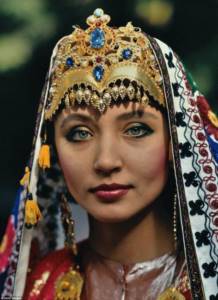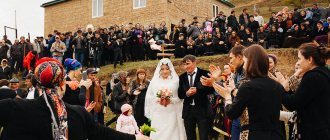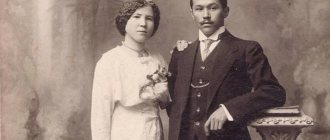Uzbek traditions and customs
Even in ancient times, tradition prescribed: when two Muslims meet, they must greet each other, regardless of whether the relationship between them was friendly or hostile. Every greeting had to be answered without fail. At the same time, the following was important: persons standing higher on the social ladder had to be the first to greet those standing below (and not vice versa!), those riding on horseback - those walking, juniors - seniors, gentlemen - their servants.
If several people greeted a person at the same time, then this person had to respond to the greeting in such a way that it was clearly visible that the return greeting applied to everyone.
In addition to the instructions on when, how and with whom one should greet, there were 11 precisely recorded moments when one should not say hello, for example:
1. When someone was in a latrine;
5. When someone was busy eating and had a “mouth full”;
8. When someone was busy reading the Qur'an;
9. When someone prayed... etc.
It was strictly forbidden to welcome cruel, ill-mannered, dishonest people. If these people themselves were the first to greet “normal” people, then their greetings should under no circumstances be answered.
Greeting each other in Uzbekistan
In Uzbekistan, it is customary to greet any person you meet along the way, even if you do not know the interlocutor. The gesture shows respect.
Interestingly, in Uzbekistan there are traditions indicating who should be the first to shake hands or nod in greeting. Younger people are always the first to greet elders, a rider on a horse is the first to greet a pedestrian, and a person of higher status is the first to show respect to his interlocutor.
Uzbek traditions prove: only men shake hands; when greeting a woman, it is customary to put your hand to your heart and nod your head.
Hospitality
One of the old rules of hospitality is that if you invite someone to your home and other people are present, you must invite everyone present. Anyone who did not follow this rule was always considered a poorly educated and disrespectful person.
Previously, an invitation should always be accepted with gratitude, but now it can be gratefully rejected if there is a good reason.
Those who accept the invitation must also follow certain rules. For example, it has long been not customary to go on a visit “empty-handed,” as they say here. Those. The guest must take small gifts with him. For example, sweets for children, a pack of tea for grandma, etc.
A large number of guests are usually invited to any significant celebration (wedding, anniversary, etc.). Traditionally, many different dishes are prepared. Every guest, if he respects the hosts, should at least try every dish. The ceremonial meal begins with numerous appetizers, then some soup is served, and then 1-2 main courses. If there is pilaf on the menu, it is usually served at the end of the feast. At this point those present understand: the holiday will soon end. But no one is rushing anyone. The guests still calmly continue to talk, drink tea, eat fruit or other dessert, and only then gradually begin to say goodbye to the owners and other guests.
Throughout the evening, a group of musicians delights the ears of guests, performing national folk and modern songs and dances. Guests pause to dance many times during the evening.
National music
The music of Uzbekistan is similar to the music of the Middle East. It has complex rhythms that give rise to a rich melodic sound. Music represents individual nuance and creative variety, although the rhythms generally follow the structures of the verse. Many of the most popular Uzbek instruments have strings, such as the rubab or dutar. Instruments similar to these are also popular in some other parts of Central Asia, Transcaucasia and the Middle East. The ancient tradition of singing minstrels, or bards, was an important part of early musical (and literary) development.
Uzbek folk music is characterized by versatility of themes and a variety of genres. Songs and instrumental pieces, in accordance with their functions and forms of existence, can be divided into two groups: those performed at a certain time and under certain circumstances and those performed at any time. The first group includes songs associated with rituals, labor processes, various ceremonies, theatrical performances, and games.
The Uzbek people are popular for their songs. Koshuk is an everyday song of verse structure with a melody of a small range, covering one or two stanzas of poetic text. Lapar and Yalla have a number of features in common with Koshuk - songs also have a verse structure. The dance nature of the melodies of this genre requires their performance accompanied by comic dances. Lapar is a dialogue song. In Khorezm they call songs performed by one singer. In some areas, the term - lapar is applied to the wedding song "Ulan" (performed as a dialogue between a man and a woman). The yalla genre includes two types of songs: a melody of a narrow range, and the chorus is a solo along with a dance. The poetic texts for the songs are folk and professional poems by poets of the East.
The most developed examples of ashula are essentially a genre of professional music of the oral tradition. A special place in the Uzbek musical heritage is occupied by dastans - epic tales of lyrical and heroic content. Maqoms constitute the main classical fund of professional music of the oral tradition.
Folk dances
Dances in different regions of Uzbekistan differ from each other. The dances of the Fergana group are distinguished by softness, smoothness and expressiveness of movements, light sliding steps, original movements in place and in a circle. In Khorezm and Bukhara they dance with kairaks (castanets).
Several stylistic directions developed in it. One of them is associated with the traditions of Bekhzod (the great artist of the Middle Ages, the founder of one of the directions of oriental miniature).
Tea party
When a guest enters the house, it is customary to immediately serve freshly brewed green tea, sweets, and fruits. While drinking tea, guests and hosts inquire about the health of those present and their family members, about business, and exchange the latest news. And only after this does custom allow one to move on to more serious topics or begin discussing problems, if any.
During tea drinking, an ancient custom is still observed: the host (hostess) pours tea into the bowl three times and pours it back into the teapot. This is done so that the brewing is then the same in all bowls. The bowl is filled with tea no more than halfway: so that the guest can hold it comfortably, so that he does not burn his fingers, so that, finally, he can look after the guest once again, demonstrating his hospitality to him.
Only in exceptional cases could an unwanted guest receive a bowl filled to the brim with tea. In this diplomatic way, they made it clear to the guest that he was here “persona non grata” and that they did not want to have any conversations with him. In this case, the guest drank tea and left. It must be said that now this custom is practically not observed.
Traditions of Uzbek hospitality
Uzbek hospitality is known all over the world. Fragrant pilaf and tea are constant treats when receiving a guest. But I would like to highlight not so much the culinary as the cultural aspect.
In Uzbekistan there are a number of rules that guests and hosts must adhere to. In the old days, women and men had to sit at different tables, but today this custom is maintained only in rural areas.
Tea is an essential component of the meal. There should always be bowls of drinks and sweets on the table, but you can start eating only after the prayer of the owner of the house. Otherwise it will be a sign of disrespect.
It’s interesting that Uzbeks try to pour less tea into their guests’ bowls? Why? Firstly, so that the person does not get burned, and secondly, the guest can more often turn to the owner with a request to pass on more tea, and he will be happy to serve him.
Uzbeks are sociable people, always ready to help their family, friends and acquaintances. And today there is a system of communities in the settlements of Uzbekistan. If any member of the community has difficulties, the rest try to help.
For example, issues of educating children, treating the elderly, and helping poor families are resolved at meetings. As a sign of gratitude for the help, people treat their neighbors and friends to pilaf.
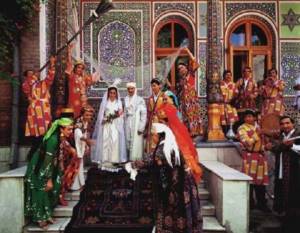
Wedding in Uzbekistan
Hashar
The Uzbek people are famous not only for their hospitality, but also for their readiness for mutual assistance. In sorrow and in joy, people try to stick together and willingly help each other. There are many examples of traditional mutual assistance.
For every Uzbek family, a very important event is the construction of a new home. Of course, experienced specialists are invited for this. But there comes a time when you need to quickly complete a certain amount of work and this requires many workers at the same time. Many people come to the aid of those under construction: relatives, friends, neighbors, acquaintances... This is where the Khashar tradition comes into force. This is the name given to joint work in favor of one or more persons.
When people are notified about hashar, no one, as a rule, refuses. It is discussed in advance what type of work needs to be completed and in what time. Together, a fairly large amount of work is completed, which ends with a common lunch or dinner.
Khashar is often organized when it is necessary to help lonely old people, the sick or disabled - for example, in renovating a house or planting a vegetable garden.
Representatives of many nationalities take part in the work. It’s not just Uzbeks who build an Uzbek house—Koreans, Russians, Tajiks, and Tatars also participate. And if a Korean or Russian needs help, then the Uzbeks will also willingly come to hashar!
Morning pilaf
custom tradition uzbek holiday
The ritual of morning pilaf is carried out during a wedding ('sunnat-tuyi' or marriage) and at funerals (after 20 days and a year from the date of death). Wedding organizers set the day and time for the morning pilaf, having previously agreed with the community of the mahalla or neighborhood committee. On this day, invitations are sent to relatives, neighbors and acquaintances. In the evening, the ceremony of 'sabzi tugrar' is carried out - chopping carrots, which is usually attended by neighbors and close relatives. After the end of 'sabzi tugrar' all participants are invited to the table. Usually, artists are also invited to sabzi tughrar. At the table during the meal, the elders distribute responsibilities among those present. Morning pilaf should be ready by the time the morning prayer ends - 'bomdod namozi', because... the first guests should be its participants. By the time the morning prayer ends, the sounds of karnaya, surnaya and tambourine notify that the morning pilaf has begun. Guests are seated at tables and after making a fotiha (wish), cakes and tea are served. Only after this is pilaf served in lyagans (large dishes) - one for two. After the meal, the lyagans are removed, the guests again perform fotiha and, having expressed gratitude to the host, leave. After they leave, the tables are quickly put in order to receive new guests. Morning pilaf usually lasts no more than one and a half to two hours. All this time, guest artists perform songs. After the end of the morning pilaf, the guests of honor are presented with gifts - usually chapans (national men's robes). Funeral pilaf differs from festive pilaf in that the guests, sitting at the tables, read suras from the Koran and remember the deceased. The meal also ends with the reading of surahs from the Koran. During the funeral pilaf, artists are not invited, and the tables are set more modestly than during the festive pilaf. It should be noted that the festive pilaf and funeral pilaf are served only by men.
The rituals of the Uzbek people have evolved over centuries as a result of a complex process of merging the cultural skills and traditions of all tribes and nationalities that participated in the ethnogenesis of the Uzbeks. They are very original, bright and diverse, going back to tribal patriarchal relations. A large number of rituals accompany family life and are associated with the birth and upbringing of a child, weddings, and funerals. A special role is played by rituals associated with the birth and upbringing of children (beshik-tuyi, khatna-kilish), marriage (fatiha-tuy, wedding). They often represent an interweaving of Islamic rituals with more ancient forms associated with magical practice. With the adoption of Islam, many family and everyday customs underwent its influence, and Muslim religious rituals entered the life of Uzbeks. Friday is considered a holiday, which is celebrated in the cathedral mosque with a general namaz (prayer). Patriarchal customs continued to exist in public life, which was concentrated in the mosque, teahouse, and bazaar and in which exclusively the male population took part.
Mentality
It is impossible to briefly describe the manners of the local residents. It is not in Uzbek customs and traditions to participate in open conflicts and show aggression - they are accustomed to kindness and politeness in all situations. This feature of the national character and culture developed in the distant past: for centuries, Uzbeks were engaged in trade, and insulting the buyer did not meet the interests of the seller. Therefore, the request will not be directly refused and instant consent will not be given either, the traditional answer is: “Okay, okay.” It’s just not known when the promise will be fulfilled - the Uzbek is in no hurry to act and make decisions.
In marriage, a woman is not equal to a man. According to Sharia, a man can have up to 4 wives, although almost no one has used this right and is content with one woman. This practice was recently banned, and a law is being drafted to criminalize imams who perform nikah (religious marriages) for men who already have one wife. Before marriage, a girl cannot have intimate relationships, otherwise she will become “unclean” and no Uzbek will want her. In such cases, women usually marry Russians.
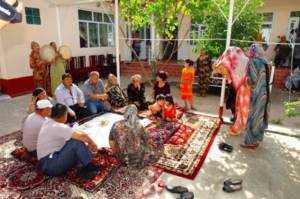
Children are raised strictly, the woman is largely subordinate to her husband and mother-in-law, and the last word always belongs to the man. The wife is respected as the keeper of the hearth, mother, spouse, but she must be submissive and take care of the housework. Even if she works equally with her husband (today an Uzbek woman can be a scientist and a businesswoman), this does not cancel the preparation of dinner for his arrival.
How to behave
When visiting sacred buildings (mosques, churches, synagogues), local customs must be unconditionally observed. Some mosques are not accessible to non-Muslims. Outside of large cities (Tashkent, Samarkand, Bukhara, Nukus), women should avoid clothing that emphasizes the figure, with bare elbows and knees.
According to the Constitution, Uzbekistan is a secular state, but Islamic culture is present in society. The province and the entire Fergana Valley are more Muslim than the country's major cities. This means that women traveling alone will find interest from Uzbek men. Uzbeks do not have the right to openly establish relationships with their girlfriends.
Beshik-tuyi
Beshik-tuyi ('wooden cradle') is a ritual celebration associated with the first placement of a baby in a cradle. This is one of the most ancient and widespread rituals in Uzbekistan. Typically, such an event is held on the 7th, 9th, 11th day of the baby’s birth. In different areas, the ritual has its own characteristics and depends on the level of wealth in the family: rich families usually celebrate this event widely, and families with little income celebrate it modestly. The beshik ('cradle') and the necessary supplies for the baby are provided by the relatives of the baby's mother. Flatbreads, sweets and toys are wrapped in a dastarkhan (tablecloth). Gifts are prepared for the baby's parents and grandparents. A richly decorated beshik, dasturkhans, gifts are loaded into a vehicle and together with the guests, to the sounds of surnay, karnay and tambourine, they go to the parents’ house. According to tradition, the brought beshik is first taken by the baby’s grandfather on his right shoulder, and then passed on to his son’s right shoulder, who then takes it to the baby’s mother. In the past, to ensure that all the thoughts of guests were pure and good, their faces were coated with white flour. Guests are invited to the living room to a richly decorated dastarkhan (table) and while the guests are eating, listening to musicians and having fun, in the next room, in the presence of old women, the ceremony of swaddling the child and placing him in the beshik is held. At the end of the ceremony, guests come to the baby to look at him, present him with gifts and sprinkle parvarda or sugar on the beshik. At this point the ceremony ends and the guests go home.
Rules of conduct for Uzbeks
Uzbek customs require special behavior and adherence to traditions from representatives of the nationality. Similar to other Muslims, Uzbeks observe fasting, completely abstaining from alcohol, cigarettes and food until sunset. In family relations, there is a strict hierarchical system of subordination to the oldest representatives of the family. Every day in Uzbekistan, according to tradition, the prayer “namaz” is said five times.
Don't say no
Uzbeks and other peoples of the eastern part of the world are very polite and kind towards others. They never say “no” and agree to any proposal or request. The only clouding communication is the lack of an exact time frame in the response. Uzbek citizens will not rush to help you, even if they agree. Aggression is also not held in high esteem here, so they try to appease every angry person in every possible way and shower them with promises.
Women are seated at a separate table
The tradition of seating women at another table still remains in rural Uzbek settlements. In ancient times, the family home was divided into two parts: women's and men's, and from there came the customs of eating at different tables and dividing responsibilities into women's and men's. Contrary to such traditions, women in the family are treated with special respect and respect, both as mothers and as spouses. But they still demand that she fulfill household obligations, even if she brings money to the family or is engaged in scientific activities together with her husband.
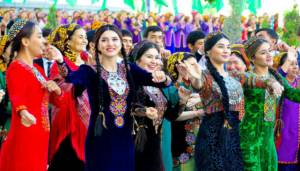
Fatiha-tuy (engagement)
The wedding takes place with the permission and blessing of the parents and is carried out in several stages. When the son reaches adulthood, the parents begin to look for a suitable girl for him. Close relatives, neighbors, and friends are included in this process. Having found a girl, the maternal or paternal aunts come to the girl’s house under some pretext to look at her, get to know the parents and the home environment of the potential bride. After this, neighbors and acquaintances ask about the chosen girl’s family. In case of positive reviews, matchmakers are sent. One of the main procedures for matchmaking is 'fatiha-tui' (engagement or betrothal). The matchmakers set the engagement day. On this day, famous old people in the area, the chairman of the mahalla, and girls gather in the girl’s house. After the intermediaries outline the goals of their coming, the ritual of 'non sindiris' (literally 'breaking a cake') begins. From this moment on, the newlyweds are considered betrothed. 'Fatiha-tuy' ends with the appointment of the day of marriage and wedding. Each of the intermediaries is given a dastarkhan with two flatbreads and sweets, and gifts are also given from the girl to the groom and his parents. Upon the return of the intermediaries to the groom's house, trays with gifts are taken from their hands and the ritual of 'sarpo kurar' (viewing of gifts) begins. Dastarkhan is usually performed by a woman with many children. All those gathered are treated to cookies and sweets brought from the bride's house. This ceremony completes the betrothal ritual. From the moment of “fatiha tui” until the wedding itself, the parents of the newlyweds resolve dowry issues and organizational issues related to the wedding celebration. A few days before the wedding, the girl had a ritual 'kiz oshi' (hen party), to which the girl invites her relatives and friends.
Cloth
The originality of the clothing of local peoples has long been determined by climatic, living conditions and tribal traditions. Back in the 19th century. clothing (robes, dresses, shirts) continued to retain archaic features: wide, long, one-piece, it flowed freely, hiding the shape of the human body. The clothing was uniform: winter and summer, men's, women's and children's, it was similar in shape to the caviar. The traditional national men's costume consists of a warm quilted robe - chapan, tied with a scarf or scarves, a skullcap headdress, and boots made of thin leather. Men wore straight-cut shirts, lower and outer robes. The robe could be light or warm, quilted with cotton wool. There were slits on the sides of the robe for convenience when walking and sitting on the floor. The robe-chapan was usually tied with a scarf or scarves. Festive national costume differs from everyday costume in the beauty and richness of the fabrics, embroideries, etc. used. Women's national costume consists of a robe, a functional dress of a simple cut made of khan-atlas, and bloomers - wide thin trousers tapered at the bottom. A woman's headdress consisted of three main elements: a cap, a scarf and a turban. A festive women's suit differs from an everyday one in the quality and beauty of the fabrics from which it is made. Children's clothing copied the clothing styles of adults. Along with the general features, the clothing of each region or tribe had its own uniqueness, expressed in the fabric used, the shape of the cut, etc.
Headdress (skullcap)
One of the most popular and widespread types of folk applied art of Uzbekistan has always been the skullcap - a hard or soft cap with a lining. The skullcap became an integral part of the Uzbek national costume and entered the life and traditions of the Uzbek people. Skullcap (from the Turkic 'tyube' - top, top) is the national headdress not only of the Uzbeks, but also of other Central Asian peoples. Skullcaps vary in type: men's, women's, children's, and for the elderly. Elderly women do not wear this headdress. Children's skullcaps (kulokhcha, kalpakcha, duppy, kulupush) are distinguished by the variety and colorfulness of the fabrics, the splendor of tassels and balls, embroidery, sparkles and an abundance of amulets. The most common shapes of Uzbek skull caps are tetrahedral and slightly cone-shaped. Skullcaps were made from two or several layers of fabric, quilted and reinforced with silk or cotton thread. The finished skullcap was embroidered with silk thread, gold or silver thread. The art of embroidering skullcaps has long been mastered mainly by women. The most common motifs decorating skullcaps include a floral motif, an almond-shaped 'bodom' motif - a symbol of life and fertility. A common pattern in skull caps is the 'ilonizi' (snake's trace) pattern, which serves as a talisman. Geometric patterns were no less popular. Skullcaps created in different regions differ in shape, ornament and color scheme.
Chust skullcaps are the most popular in many regions of Uzbekistan. Duppy - the most common type of skull cap in Chusta - is characterized by a black background and a white pattern in the form of four pepper pods - 'kalampir'; The band is embroidered in rows. There are three types of duppy - round, tetrahedral-rounded and cap extended upward. Chust duppies (black background and embroidered white pattern) are distinguished by the “coolness” of the ornament (a full almond with a short and sharply bent tendril) and the significant height of the band. Other types of skullcaps from the Fergana Valley - 'Sandals', 'Akka ikki sum', 'Chimboy', 'Surkachekma', etc., are distinguished by the simplicity of their motifs. Samarkand skullcaps are made using the 'piltaduzi' technique. There are other types of skullcaps - the Urgut skullcap 'kalpok', the Bukhara gold-embroidered skullcap, the Shakhrisabz skullcap 'gilam duppy', the Kitab and Shakhrisabz skullcaps 'sanama' and 'chizma', 'takhya', 'tayha', 'chumakli', 'kush' - men's and women's Khorezm skullcaps. The most common ornament on skullcaps was a pepper-shaped pattern (a symbol of purity and detachment from everything earthly), crosses, bunches of feathers, a nightingale motif, birds (a symbol of higher wisdom), rose branches (a symbol of peace and beauty), inscriptions sacred Arabic script, etc.
Hospitality and tea drinking
Although the Uzbeks themselves dress rather sadly - black and shades of gray, they are very cheerful and love to joke. Hospitable, happy to share everything they have. Dastarkhan must be filled so that there is no free space left. There are fruits, berries, vegetables (especially melons and watermelons), flatbreads, cold appetizers, and not to mention sweets.
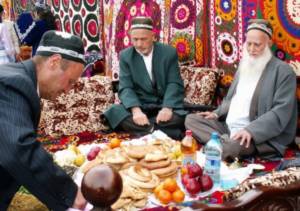
Since ancient times, a traveler passing by was supposed to be invited into the house and treated to bread and tea. The one who receives guests must be friendly and friendly, be able to skillfully serve food, and show equal respect to all guests. The custom of treating friends and neighbors with the first fruits from one’s garden is still alive.
The Japanese and Chinese have their own ritual of taking a tea drink; Uzbeks are also sensitive to this, starting and ending with tea when eating. Green tea is the most popular; black tea is drunk in Tashkent. They are consumed without sugar, but certain herbs and spices are added. The hosts first set the table, decorating it with various sweets and fruits. Then the bowls are placed and a kettle of freshly brewed tea is brought. The owner pours a little drink into the bowl, then returns it to the kettle - and so on 3 times. Finally, he fills the container halfway and serves it to the guest. To an uninitiated person, it seems that some kind of ritual is being performed, but in reality everything is much more prosaic. Dry tea leaves, after pouring boiling water, release their aroma too slowly, and pouring helps to mix them evenly and speeds up the process.
Briefly about the brewing process. The porcelain steamer is first heated, then dry leaves are poured in, and a little (about a quarter) of boiling water is added. Simmer for some time by steaming or in the oven. What's the hurry? This is the East. Then fill it halfway, leave it to steep, and add hot water again. It will take a few more minutes until it starts to pour. In some regions, milk is added to tea.
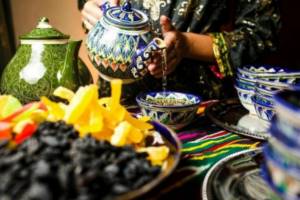
They do not top up the drink so that the guest does not get burned, but the main thing is that later he asks to add more, which they will do with pleasure, since the traditions of the Uzbek people require respect for the traveler and care for him. When bringing tea to a dear guest, they put their right hand to their heart as a sign of respect. Joke: the Uzbek is so greedy - he not only pours half the tea, but also clings to his heart!
Chaikhona (teahouse) is the same unshakable element of local traditions as tea. Social life is centered around mosques, bazaars and teahouses. In the teahouse, hiding from the scorching sun, people talk, relax, share news and have lunch. In addition to tea, you can order food, as well as wine or beer. Uzbekistan is a Muslim country where alcohol is legal.
Uzbek wedding: customs and traditions
A special scope and observance of many traditions are the main distinguishing features of a truly colorful Uzbek wedding. How it differs from the European one and what its features are, this is what the Svadebka.ws portal is in a hurry to tell you.
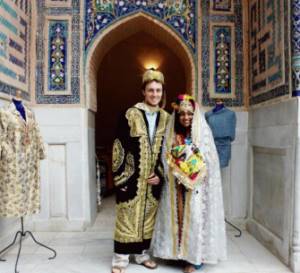
Wedding in Tashkent: Uzbek customs from the beginning to the end of the celebration
The Eastern nation has always been distinguished by the wide scale of its celebrations. And when it comes to a wedding, the festivities certainly don't end in just one day. But the celebration is not limited to banal painting in the registry office and gatherings at the festive table. Before marriage, an engagement ceremony takes place - fatiha-tuy, at which the bride's mother receives gifts from the groom's parents. This is most often money, lamb, national delicacies and expensive fabrics. An Uzbek wedding is simply imbued with the most interesting traditions and customs. Where does the wedding ceremony begin and how to organize a modern wedding in the East?
Morning pilaf
The usual wedding morning consists of getting ready for the bride and groom, meeting with relatives and a small buffet. An Uzbek wedding begins with morning pilaf, which is prepared by the families of the bride and groom. By the way, the event is necessarily held early in the morning and only males are allowed to attend. Sometimes only the groom's family is involved in the preparations, sending part of the meal to the bride's house along with congratulations. Today, this Uzbek tradition at weddings is supported in a slightly different format and pilaf is served in a cafe or teahouse in Tashkent and other cities, freeing the hosts from unnecessary hassle.
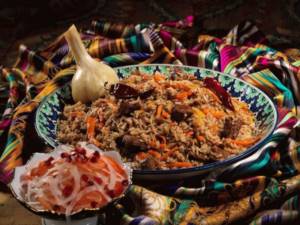
Ceremony or official part
After the morning pilaf, the groom, accompanied by close relatives, hurries to the bride's house. A girl, dressed in a wedding dress with her face covered with a veil, is waiting for her lover in a separate room along with the clergyman - the imam. Next, the young people need to perform several customs:
- Honey treat, during which the groom will taste some honey and give it to the bride to taste from his own hands. This action is a symbol of the sweet life. At the end of the ceremony, the newlyweds need to see each other in a mirror that no one has looked into before.
- Gifts for the bride, generously given by the groom. The beloved can receive bracelets and watches from her man’s hand as a gift. The main condition is that the groom himself is obliged to put them on the bride’s hands.
- Laying out the tablecloth for meals - dastarkhan - is the final rite before marriage. Cakes and sweets are laid out on it, inviting a rich life to the bride and groom's home.
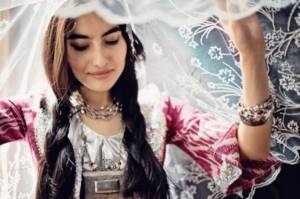
Niko thuy or magnificent Uzbek wedding
Bride ransom
Yes, don’t be surprised, this custom is usually carried out exactly after the main celebration of the wedding. How does the bride ransom work? The bride and groom come to a room specially designated for them, where a friend or close relative - yanga - is already waiting for the bride. She changes the girl's clothes, preparing her for her first night with her husband. It is the yanga who demands a ransom for the first wedding night and only after that the newlyweds can be left alone.
Kelin salom or greeting of the bride
The next morning, or according to another version, three days later, begins with another tradition of the Uzbek wedding - the reception into a new family, Kelin salom. The groom's parents and relatives gather in the courtyard, where they present the young wife with expensive gifts. The daughter-in-law is obliged to bow deeply to everyone. It is after this custom that the girl becomes a full member of the new family.
Features of the national mentality
Customs in Uzbekistan are traditionally passed on from generation to generation. The veneration of elders and the respect shown to them forces modern residents of the country to maintain the mentality and adhere to ancient traditions, which sometimes seem very unusual.
Solve problems around the world
Another Uzbek tradition, which has long been enshrined in law, is an unusual form of decision-making. In each city, the community elects a special committee, dependent on the highest authorities. The committee helps people solve their problems and make decisions. For example, it helps children enroll in schools and universities, gives families who want to divorce time to think and the opportunity to change their decision. It is customary to thank for help through work: for example, feeding neighbors morning pilaf if they helped in building a house.
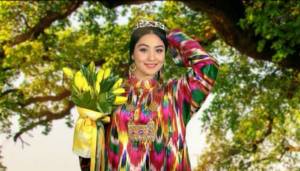
Until recently they were polygamists
It is known that some eastern peoples allow polygamy, and this was the case in Uzbekistan until recently. In addition to the official registration of marriage in the country, there is a religious wedding in a temple called Nikoh. Previously, these two events were not connected, and Uzbek men officially registered their marriage with one wife, and then performed the wedding ceremony with the other, thereby finding themselves married to two women at once. Now nikoh and marriage registration are inextricably linked; Uzbek law does not allow living with a woman anymore if the man registered the marriage, but did not perform the wedding ceremony according to tradition.
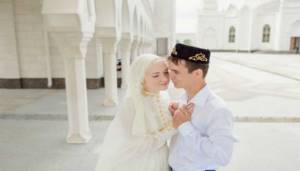
Marry according to the will of their parents
The Uzbek peoples show great respect for the older generation and their choice, so there has long been a tradition of parents selecting a bride or groom. Since childhood, older family members have been negotiating the wedding of two young people, who often do not even know each other. But in rare cases, a girl may refuse to become a man’s wife, even if the groom was chosen by her parents.
They pay bride price for the bride
Kalym is a kind of ransom for the bride. Before any Uzbek wedding, the parents of the newlyweds agree on the amount that each spouse will pay or spend on the young family. Sometimes they discuss a sum of money, sometimes the purchase of an apartment or house. The ransom amount varies and depends on the welfare of each family and the area of residence of the couple. The tradition of paying bride price for Uzbek brides dates back to ancient times. In some regions, the bride price is much larger on the part of the groom, who can pay up to several thousand dollars for his bride. In other regions, the bride's family pays the ransom, giving a large dowry along with their daughter.
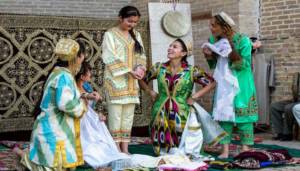
Uzbek brides: features of wedding dress
The traditional wedding attire of Uzbek brides deserves special attention. However, the bride always has the opportunity to choose a European dress for the celebration. The Svadebka.ws portal will tell you below what the national wedding attire should be.
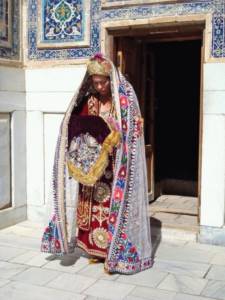
The dress is made from khan-atlas, a type of silk fabric widely used in Uzbekistan. The bride usually wears silk harem pants under her dress. Over the wedding dress, a skillfully embroidered sleeveless vest, a silk robe or a velvet camisole embroidered with gold threads is worn.
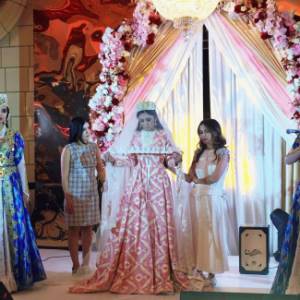
Particular attention is paid to the bride's headdress. National Tiplya-kosh is a kokoshnik, decorated with a large number of pendants and openwork embroidery. The girl's face must be covered with a veil.
